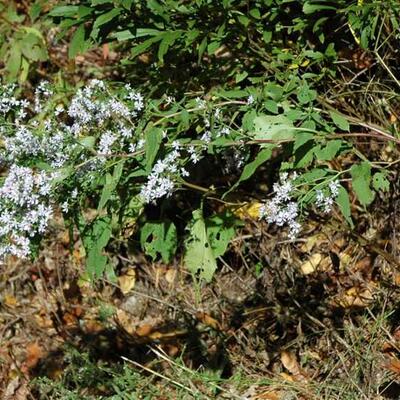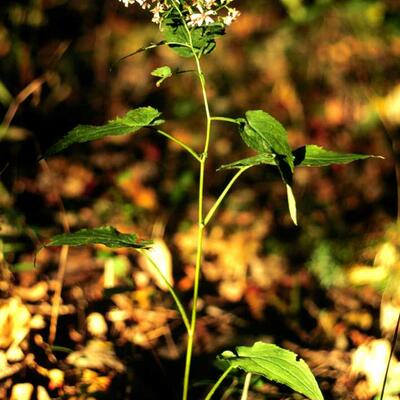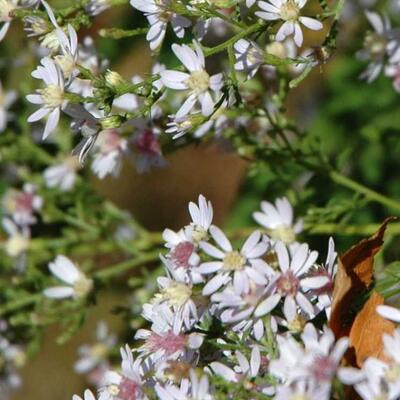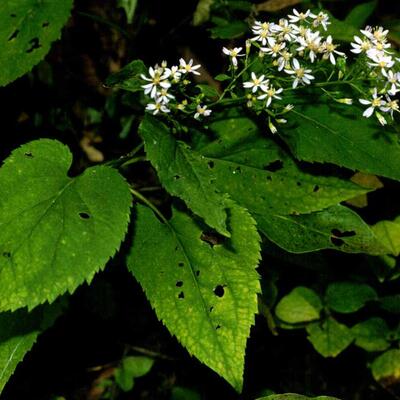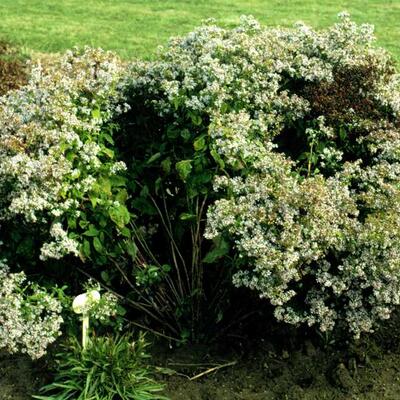Department of Biology
ESC 350
200 University Ave. W
Waterloo, Ontario, Canada N2L 3G1
Phone: (519) 888-4567 ext. 32569
Fax: (519) 746-0614
Heartleaf Aster, Common Blue Wood Aster, aster cordifolié
Symphyotrichum cordifolium (L.) Nesom is native to rich, mostly mesic, rocky to loamy soils, open wooded slopes and bluffs, stream banks, moist ledges, swampy woods, borders of beech-maple or oak-hickory forests, clearings, thickets, roadsides, and along ditches in deciduous forests from Nova Scotia to eastern Manitoba south to Georgia and eastern Oklahoma (Brouillet et al. 2006; FNA). The bases of basal and lower stem leaf blades are usually ± deeply cordate, sometimes rounded becoming reduced upward with ovate to lanceolate blades with rounded, attenuate, or cuneate bases. Ray florets are usually blue to purple, seldom whitish or pink. The species was introduced in British Columbia but has not persisted.
Legault (1986) showed that the varieties described are not distinct and mostly represent phenotypic variants caused by growing conditions; likewise, diploid and tetraploid races could not be distinguished morphologically. A small shoot with few flowers can become a very large plant when transplanted from the wild to a well watered experimental garden (see last two images below).
There are numerous synonyms: Aster cordifolius L.; A. cordifolius var. alvearius Burgess; A. cordifolius var. furbishiae Fern.; A. cordifolius var. incisus Britt.; A. cordifolius subsp. laevigatus (Porter) A.G. Jones; A. cordifolius var. laevigatus Porter; A. cordifolius var. lanceolatus Porter; A. cordifolius var. moratus (Shinners) Shinners; A. cordifolius var. polycephalus Porter; A. cordifolius var. racemiflorus Fern.; A. cordifolius subsp. sagittifolius (Wedemeyer) A.G. Jones; A. cordifolius var. sagittifolius (Wedemeyer) A.G. Jones; A. finkii Rydb. var. moratus Shinners; A. leiophyllus Porter; A. lowrieanus Porter; A. lowrieanus var. incisus (Britt.) Porter; A. lowrieanus var. lanceolatus (Porter) Porter; A. sagittifolius Wedemeyer; Symphyotrichum cordifolium var. furbishiae (Fern.) Nesom; S. cordifolium var. lanceolatum (Porter) Nesom; S. cordifolium var. moratum (Shinners) Nesom; S. cordifolium var. polycephalum (Porter) Nesom; S. cordifolium var. racemiflorum (Fern.) Nesom; S. lowrieanum (Porter) Nesom; S. sagittifolium (Wedemeyer) Nesom
The species includes diploids 2n=16 and tetraploids 2n=32.
Symphyotrichum cordifolium, large plant, Macon Co., North Carolina
Symphyotrichum cordifolium, small shoot, Semple & Brouillet 3733 WAT, Ohio
Symphyotrichum cordifolium, heads, Macon Co., North Carolina
Symphyotrichum cordifolium "lowrieanum" morph in woods, Cocke Co., Tennessee
Symphyotrichum cordifolium "lowrieanum" morph, transplanted to experimental garden, Waterloo, ON
Legault, A. 1986. Cytogéographie et Taxonomie Infraspécifique de l’Aster cordifolius L. (Asteraceae) au Québec. M.S. thesis. Université de Montréal.
Brouillet, L., J.C. Semple, G.A. Allen, K. Chambers and S. Sundburg. 2006. Symphyotrichum Nees. pp. 465-539. In Flora North America Editorial Committee, eds. Flora of North America. Vol. 20. Asteraceae, Part 2. Astereae and Senecioneae. Oxford University Press, New York.
Revised 11 May 2021 by J.C. Semple
© 2021 J.C. Semple, including all photographs unless otherwise indicated
